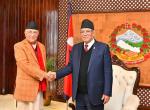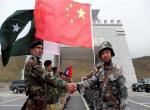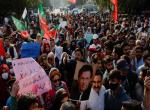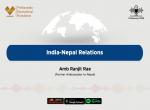‘My civilisation is lost. My lifetime of worshipping has gone in vain. I am a lost man and lost I will be…Please save my future generation! Please’ cried Satyapriya Mahathero, the second senior most Buddhist monk in Bangladesh. The 83-year old Mahathero’s monastery – the Kendriyo Sima Vihar – was vandalized and the Buddha statues in it defaced and burnt in the attacks on Buddhist and Hindu temples at Ramu, Ukhia, Patia and Teknaf under Chittagong Division on 29th and 30th September. The venerable monk barely escaped with his life when his followers managed to whisk him away to a nearby paddy field during the attack.
According to the Delhi based Asian Centre for Human Rights (ACHR) at least 24 temples were burnt down and dozens of Buddhists villages were attacked, leaving thousands homeless. The Ramu sub-district with 15 burnt Buddhist temples was the worst affected. Two Hindu temples – Kolegaon Nabarun Sangha Durga Mandir and the Matri Mandir in Patia sub-district were also burnt. The 250 year old Cheranghata Barakyang Buddhist Vihara was also torched and desecrated. Eyewitness reports indicate that mobs sprinkled gun powder and petrol and torched the monasteries obstructing and thrashing monks who attempted to douse the flame.
A number of leading commentators in Bangladesh have accepted that the attacks on the minority communities are a ‘blot on the nation’s conscience’ and have termed the massacres as unprecedented. ‘Never before in our history have places of worship of a religious minority been ravaged on such a large scale and in so deliberate a manner’ commented the editor of one of the leading dailies of Bangladesh. The law enforcement agencies and their initial role as bystanders despite repeated appeals and warnings by the minority community leaders that a tense communal situation was developing has also come in for a lot of flak. The role of the officer in charge (OC) of the Ramu police station has also come under the scrutiny. On the night of the attacks the OC was seen sharing stage with the organisers of the protest rally and making provocative statements.
There seems to be no doubt that the attack was ‘premeditated, pre-planned and quite meticulously organised’. Investigative sources have revealed that the planning took place at least four days in advance and the sudden spurt in the number of attackers points to a well-laid plan. The reason for the attacks, the tagging of a photograph that was ‘insulting to the Muslims’ onto the Facebook account of a Buddhist, Uttam Kumar Barua and the rapidity with which it was electronically disseminated among the members of the majority community was itself an indication that the entire operation was a planned affair. In fact, Barua, himself unaware of the tag, immediately removed it and had to go into hiding leaving his family under police protection. It was as if a trigger was being awaited to attack the Buddhists and the Hindus in Chittagong.
The entire procedure of broadcasting the pictures through sms and blue tooth and create a situation of unrest is reminiscent of the forced exodus of people from the North-East from Bangalore in India earlier this year. The other aspect which points towards a pre-meditated attack is that most of the attackers seemed to have been outsiders who were brought to the spot overnight in buses and trucks. According to eyewitnesses the vandals were mostly aged between 14 and 22 and were being egged on by leaders from the rear. Agencies have also reported that a number of Rohingya Muslim groups also participated in the attack on the Buddhists in retaliation to attacks on them in Burma. Whether it is Azad Maidan in Mumbai, or the threats to people from the North-East in Bangalore, or Masuri in Ghaziabad or Chittagong in Bangladesh, the modus operandi of engineering communal unrest seems to be strikingly similar.
In Patiya, where the Durga temple was attacked and the idols demolished, many among the mob, police reports indicate, belonged to the Jamaat dominated workers union of the nearby Western Marine Shipyard. Locals also say that a number of leaders belonging to different political parties who were also seen in the crowd did not do anything to calm down the situation. In fact, the minorities in Bangladesh have been at the receiving end regardless of which party is in power. Things seem to only marginally improve for them whenever the Awami League (AL) is at the helm but the local party apparatchiks of the AL keep flouting the diktats of its Central leadership vis-à-vis the protection of minorities.
Chittagong remains the stronghold of the BNP and especially of the Jamaat. The CHT areas too continue to remain volatile with a major flare up and attack on the Jummas taking place on 22nd September this year. Following a minor altercation, Bengali settlers attacked the indigenous Jummas leaving around 40 of them seriously injured. Even there the attack and the rapidity with which it spread seemed to have been planned much in advance. In the past too Chittagong, Hathazari, Cox’s Bazar and the CHT has seen a large number of radical Islamist groups operate. The Awami League government does not seem to have taken stringent steps in the past three years to curb the activities of the Jamaat and other Islamist groups in the area. The Rohingya issue has also kept alive the simmering tensions and possibilities of conflagration in the area. In areas where the Rohingyas dominate, the Buddhists have been badly threatened and have been asked to leave the country. The slogans the Rohingyas repeatedly gave on the days following the attack called for burning Buddhists temples and homes. A large number of Buddhists localities in the region have been deserted and the conditions in the refugee camps are reported to have become highly unlivable.
The minorities in Bangladesh, despite official reassurances and support from a large section of the urban intelligentsia, continue to be insecure and remain at the mercy of organised Islamist political and militant groups. The attacks and desecration at Ramu have again brought the issue to the fore and India, revered as the ‘land of the Buddha’, ought to take note of the developments and express concern. Silence on its part will only strengthen the disruptive communal forces and encourage further attacks on the minorities in Bangladesh.
Trailokyanath Chakrabarti alias Maharaj (1889-1970) the legendary leader of the Dhaka Anushilan Samiti who spent three decades in British jails fighting for Indian independence and who chose to continue living in East Pakistan after independence in 1947 was himself witness to anti-minority riots in Dhaka in 1964. The 75 year old former revolutionary had to be transported to a refugee camp in the capital for safety. From the confines of his camp Chakrabarti managed to write a letter to the Hindusthan Standard in India. Portions of his heart rending letter bears repetition under present circumstances:
“What happened this time is not rioting which can occur only between two contending parties, but one sided attack, looting and killing. One side attacks and the other side flees in fear of life. Those who have been victims of looting or have been killed ask ‘What crime have we committed since we do not dabble in politics, do not meddle with the activities of the people of the other community, do not quarrel with our neighbours, are citizens of this country, share its prosperity, sorrow or happiness, pay government taxes regularly, are loyal…then why should we be killed, why our houses should be looted and burnt…”
Nearly five decades later the situation has hardly altered – or, more accurately, has changed for the worse - and these questions continue to remain relevant. Satyapriya Mahathero too made much the same point when he said, surveying the extent of the damage done to his monastery, ‘This attack is totally out of the blue…This is an attack on my religion. I have no foes.’
The minorities of Bangladesh ask the same questions and they continue to struggle in trying to find answers.
Published Date: 8th October 2012










Post new comment